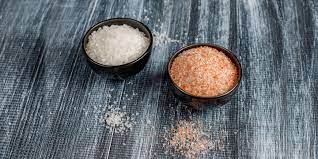Salt, a staple in kitchens worldwide, isn’t just a simple condiment. With an array of types and sources, understanding salt can elevate your culinary game and impact your health choices. Among the plethora of options, two stand out – Himalayan Salt and Table Salt. Both have their advocates, but what makes them distinct?
What is Himalayan Salt?
Majestically pink and visually striking, Himalayan salt is mined from the Punjab region in Pakistan, close to the Himalayas. Its origin dates back to ancient seas millions of years ago. This salt gets its unique color from trace minerals like magnesium, potassium, and calcium. The traditional methods of manually extracting and minimally processing it preserve its natural state and rich mineral content.
What is Table Salt?
Table salt, the white, fine-grained salt most of us grew up with, primarily comes from salt mines or evaporated sea water. Its refinement process strips away most natural minerals, leaving almost pure sodium chloride. To prevent clumping, anti-caking agents are added. Plus, it often gets fortified with iodine, an essential nutrient for thyroid function.
Nutritional Comparison
Himalayan salt, with its diverse mineral composition, offers more than just sodium. It boasts small amounts of over 80 minerals, including iron (which gives it its pink tint). On the other hand, table salt is predominantly sodium chloride. While Himalayan salt’s mineral content sounds impressive, the amounts are minuscule, so it’s not a significant source of daily minerals. Iodine, added to table salt, is its nutritionally redeeming feature, aiding thyroid function and preventing deficiencies.
Taste and Culinary Applications
Connoisseurs claim that Himalayan salt provides a softer, more nuanced flavor, making it ideal for finishing dishes. Its chunky crystals can enhance texture, especially in salads and grilled meats. Table salt, with its fine grain, dissolves quickly, making it apt for baking and general cooking. Experimenting with both in various dishes can reveal distinct taste profiles.
Health Benefits and Concerns
Himalayan salt’s purity and minimal processing mean fewer additives, making it a favorite among health enthusiasts. But sodium intake, regardless of its source, should be moderated. Overconsumption is linked to hypertension and cardiovascular issues. As for iodine in table salt, it’s crucial in areas where iodine-rich foods (like seafood) are scarce. However, too much iodine can be harmful. It’s all about balance.
Environmental and Ethical Considerations
Himalayan salt’s mining has both environmental and ethical implications. Large-scale mining can disrupt local ecosystems. Plus, concerns about worker exploitation in salt mines exist. In contrast, sea salt production, a source of table salt, impacts marine ecosystems. It’s always wise to purchase from brands that prioritize sustainable and ethical practices.
Price and Availability
A quick market scan reveals Himalayan salt often costs more than its table counterpart, reflecting its exotic origin and marketing as a gourmet product. While table salt is ubiquitously available, Himalayan salt can be found in specialty stores or online. As with most products, you often get what you pay for.
Aesthetic and Practical Uses Beyond Cooking
The pink glow of Himalayan salt lamps has graced many interiors, purportedly offering air purification and mood enhancement. While scientific backing is scant, they undeniably add ambiance. Table salt isn’t just for eating; it’s a handy cleaning agent, stain remover, and even a throat gargle when dissolved in warm water.
Final Thoughts and Recommendations
Whether you’re seasoning your favorite dish or looking to revamp your health choices, both salts have their place. We recommend trying both and discerning the difference yourself. It’s essential to balance taste, health, environmental considerations, and budget.
Conclusion
Himalayan and table salt, each with their unique qualities, hold a spot in our kitchens and our hearts. Knowing their differences helps in making an informed choice. As with everything, moderation is key. Now, it’s over to you. Which salt reigns supreme in your kitchen?
Frequently Asked Questions (FAQs):
1. Where is Himalayan salt sourced from?
Himalayan salt is primarily mined from the Punjab region of Pakistan, near the Himalayan mountain range.
2. Why is Himalayan salt pink?
The pink hue of Himalayan salt is due to trace minerals like iron, magnesium, potassium, and calcium present in it.
3. What additives are commonly found in table salt?
Table salt usually contains additives such as anti-caking agents to prevent the grains from clumping together. Many brands also add iodine, which is essential for thyroid function.
4. Is one type of salt healthier than the other?
Both salts contain primarily sodium chloride, but Himalayan salt has trace minerals that table salt lacks due to its refinement process. However, these minerals are present in minimal amounts, so neither salt can be considered a significant source of them. The health impact largely comes from the amount of salt consumed, not the type.
5. Which salt should I use for cooking?
Both salts can be used for cooking. Table salt, with its fine grain, dissolves quickly, making it suitable for baking and general cooking. Himalayan salt, due to its larger crystals and nuanced flavor, is often preferred as a finishing salt for dishes.
6. Are there any environmental concerns with salt extraction?
Yes. Himalayan salt mining can disrupt local ecosystems, and there are also concerns about worker conditions in some mines. Sea salt production, another source for table salt, can affect marine environments. It’s recommended to buy from brands that emphasize sustainability.
7. Why is iodine added to table salt?
Iodine is added to table salt to prevent iodine deficiency disorders, such as goiter. Iodine is essential for the production of thyroid hormones.
8. Can I use table salt in place of Himalayan salt and vice versa?
Yes, in most cases, they can be used interchangeably in recipes. However, due to flavor and texture differences, you might notice subtle variations in the final dish.
9. What are Himalayan salt lamps, and do they have health benefits?
Himalayan salt lamps are decorative lamps made from chunks of Himalayan salt. Some claim they purify the air and boost mood, though scientific evidence supporting these claims is limited.
10. How should I store my salt?
Both Himalayan and table salt should be stored in a cool, dry place, ideally in an airtight container. This will prevent moisture from affecting the salt’s texture and quality.

